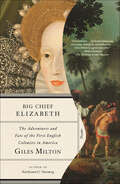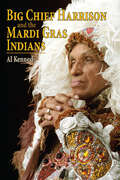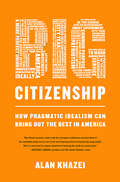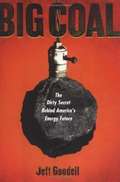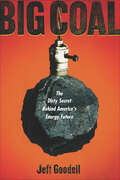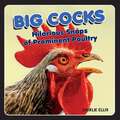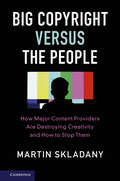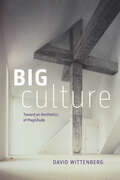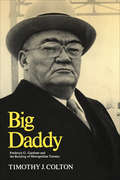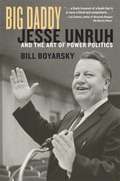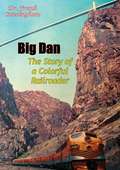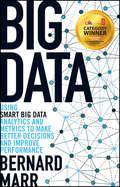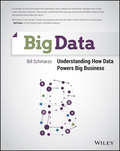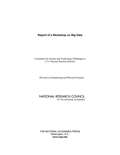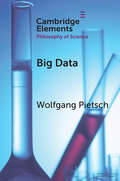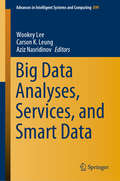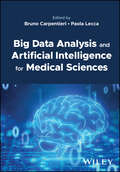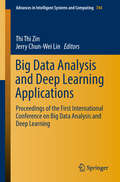- Table View
- List View
Big Chief Elizabeth: The Adventures and Fate of the First English Colonists in America
by Giles MiltonIn April 1586, Queen Elizabeth I acquired a new and exotic title. A tribe of Native Americans had made her their weroanza—a word that meant "big chief". The news was received with great joy, both by the Queen and her favorite, Sir Walter Ralegh. His first American expedition had brought back a captive, Manteo, who caused a sensation in Elizabethan London. In 1587, Manteo was returned to his homeland as Lord and Governor, with more than one hundred English men, women, and children, to establish the settlement of Roanoke, Virginia. But in 1590, a supply ship arrived at the colony to discover that the settlers had vanished.For almost twenty years the fate of Ralegh's colonists was to remain a mystery. When a new wave of settlers sailed to America to found Jamestown, their efforts to locate the lost colony of Roanoke were frustrated by the mighty chieftain, Powhatan, father of Pocahontas, who vowed to drive the English out of America. Only when it was too late did the settlers discover the incredible news that Ralegh's colonists had survived in the forests for almost two decades before being slaughtered in cold blood by henchmen. While Manteo, Sir Walter Ralegh's "savage," had played a pivotal role in establishing the first English settlement in America, he had also unwittingly contributed to one of the earliest chapters in the decimation of the Native American population. The mystery of what happened to the Roanoke colonists, who seemed to vanish without a trace, lies at the heart of this well-researched work of narrative history.
Big Chief Harrison and the Mardi Gras Indians
by Al KennedyA biography of the life, work, and legacy of a pivotal figure in New Orleans cultural history. Based on more than seventy interviews with the subject and his close friends and family, this biography delves deep into the life of Donald Harrison—a waiter, performer, mentor to musicians, philosopher, devoted family man, and, most notably, the Big Chief of the Guardians of the Flame, a Mardi Gras Indian tribe. The firsthand accounts and anecdotes from those who knew him offer insight into the electrifying existence of a man who enriched the culture of New Orleans, took pride in his African American heritage, and advocated education throughout the city. Beneath a vibrant costume of colorful feathers and intricate beading stood a man of conviction who possessed a great intellect and intense pride. Harrison grew up during the Great Depression and faced discrimination throughout his life but refused to bow down to oppression. Through determination and an insatiable eagerness to learn, he found solace in philosophy, jazz, and art and spiritual meaning in the Mardi Gras Indian tradition. He shared his ideals and discoveries with his family, whom he protected fiercely, until he took his last breath in 1998. Harrison&’s wife, children, and grandchildren continue to carry his legacy by furthering literacy programs for New Orleans&’ youth. From Harrison&’s birth in 1933 to his desire to become a Mardi Gras Indian to the moment he met his beloved wife, author Al Kennedy shares Harrison&’s significant life experiences. He allows Big Chief Donald to take center stage and explain—in his own words—the mysterious world of the Mardi Gras Indians, their customs, and beliefs. Rare personal photographs from family albums depict the Big Chief with his family, parading through the streets on Carnival Day, and performing the timeless rituals of the Mardi Gras Indians of New Orleans. This well-researched biography presents a side of the Big Chief the public did not see, revealing the rebellious spirit of a man who demanded respect, guarded his family, and guided his tribe with utmost pride. Praise for Big Chief Harrison and the Mardi Gras Indians&“Enormously enjoyable, richly informative, and deeply moving. . . . To meet the Harrisons is to encounter an America you can't help but fall in love with and be inspired by forever, while gaining a glimpse into the powerful and meaningful tradition of the Mardi Gras Indians in New Orleans. It's a story of strength, passion, survival, and resistance. It&’s a story for today.&” —Jonathan Demme, Academy Award–winning director&“Building on his impressive knowledge of New Orleans culture, Al Kennedy delivers a masterpiece of artistic biography. The world needs to know about Big Chief Donald Harrison, Sr. Al Kennedy tells his full story in this wonderful book. . . . A powerful read.&” —Robert Farris Thompson, Col. John Trumbull Professor, History of Art; Master of Timothy Dwight College, Yale University; and author, Tango: The Art History of Love, Face of the Gods, and Aesthetic of the Cool
Big Citizenship: How Pragmatic Idealism Can Bring Out the Best in America
by Alan KhazeiThe story of the realization of one manOCOs vision: of how much greater America would be if people from all walks of life joined together in a shared act of national service
Big City Elections in Canada
Local elections are an increasingly popular area of research among scholars of Canadian political behaviour, offering invaluable insights into the attitudes and motivations of Canadian electors. The Canadian Municipal Election Study (CMES) has collected unparalleled individual-level survey data in eight major Canadian municipal elections: Vancouver, Calgary, Winnipeg, London, Mississauga, Toronto, Montreal, and Quebec City. These elections, which took place in 2017 and 2018, were high-profile, contentious, and often surprising, featuring mayoral defeats, record-breaking turnouts, provincial-municipal tensions, and the first ranked-ballot election in Canada in decades. Combining unprecedented individual-level survey data from the CMES with local expertise from political scientists across Canada, Big City Elections in Canada provides a data-driven overview of each election, while also highlighting the more general lessons the elections teach us about municipal politics and voting behaviour. The chapters in this book make substantial empirical and theoretical contributions to the voting behaviour and urban political science subfields and will appeal to students, journalists, and engaged citizens who are interested in learning more about municipal elections in their cities.
Big Coal: The Dirty Secret Behind America's Energy Future
by Jeff GoodellPresident Bush has said coal is America's "economic destiny." Despite a century-long legacy that has claimed millions of lives and ravaged the environment, why has coal become hot again? Few of us realize that coal already supplies more than half the energy needed to power our iPods, laptops, lightsanything we use that consumes electricity. Every time we flip on a switch, we burn a lump of coal. Our desire to find a homegrown alternative to Mideast oil, the rising cost of oil and natural gas, and the fossil fuelfriendly mood in Washington will soon push our coal consumption through the roof. Because we have failed to develop alternative energy sources, coal has become the default fuel for the twenty-first century. In the tradition of Rachel Carson and Eric Schlosser, the veteran journalist Jeff Goodell examines the faulty assumptions underlying coal's revival and shatters the myth of cheap coal energy. In a compelling blend of hard-hitting investigative reporting, history, and business analysis, Big Coal illuminates the stark economic imperatives America faces and the collusion of business and politics that has already set us on the dangerous course. Filled with troubling environmental and health revelations, Big Coal shows us that our shiny white iPod economy is propped up by dirty black rocks.
Big Coal: The Dirty Secret Behind America's Energy Future
by Jeff GoodellNew York Times–Bestselling Author:“Should be ready by anyone who owns a microwave, or an iPod, or a table lamp, which is to say everyone.” —Elizabeth Kolbert, Pulitzer Prize–winning author of The Sixth ExtinctionA Kirkus Reviews Best Book of the YearCoal is still a significant source of power in the United States—and coal mining is still a deadly and environmentally destructive industry. Much of the carbon dioxide released into the atmosphere each year comes from coal-fired power plants, and in recent decades air pollution from coal plants has killed more than half a million Americans. In this eye-opening call to action, Jeff Goodell explains the costs and consequences of America’s addiction to coal and discusses how we can kick the habit.“[A] compelling indictment . . . powerful.” —The New York Times Book Review“Goodell’s description of the mining-related deaths, the widespread health consequences of burning coal and the impact on our planet’s increasingly fragile ecosystem make for compelling reading, but . . . are not what lift this book out of the ordinary. That distinction belongs to Goodell’s fieldwork, which takes him to Atlanta, West Virginia, Wyoming, China and beyond.” —Publishers Weekly (starred review)“Goodell does a first-rate job of balancing environmental concerns with interviews from the human faces associated with ‘Big Coal’.” —Library Journal
Big Cocks: Hilarious Snaps of Prominent Poultry
by Charlie EllisPROUD. ERECT. COCKS. You won’t believe your eyes. This book contains some of the world’s most impressive cocks! Paired with hilarious captions, these pics will have your jaw hitting the floor in no time. Go on – you know you want to sneak a little peak at these beautiful sturdy beasts!
Big Cocks: Hilarious Snaps of Prominent Poultry
by Charlie EllisPROUD. ERECT. COCKS. You won’t believe your eyes. This book contains some of the world’s most impressive cocks! Paired with hilarious captions, these pics will have your jaw hitting the floor in no time. Go on – you know you want to sneak a little peak at these beautiful sturdy beasts!
Big Copyright Versus the People: How Major Content Providers Are Destroying Creativity and How to Stop Them
by Martin SkladanyWhen the idea of copyright was enshrined in the Constitution it was intended to induce citizens to create. Today, however, copyright has morphed into a system that offers the bulk of its protection to a select number of major corporate content providers (or Big Copyright), which has turned us from a country of creators into one of consumers who spend, on average, ten hours each day on entertainment. In this alarming but illuminating book, Martin Skladany examines our culture of overconsumption and shows not only how it leads to addiction, but also how it is unraveling important threads - of family, friendship, and community - in our society. Big Copyright versus the People should be read by anyone interested in understanding how Big Copyright managed to get such a lethal grip on our culture and what can be done to loosen it.
Big Crime and Big Policing: All about Big Money?
by Stephen Schneider Tonita Murray Elizabeth KirleyFollowing money over national borders, banking systems, casinos, and free trade zones, as well as the world of the corrupt elites, Big Crime and Big Policing brings new scholarly and practical insights into our understanding of the interplay of money, crime, and policing on the grand scale. In this wide-ranging volume, a mixed group of scholars and practitioners aim to show how money dictates the scope and nature of financial and corporate crimes, and the impact of these crimes on national economies, social institutions, and communal well-being alike. The book examines how the combined efforts of governments and international organizations fail to stop financial crime at its source and, despite apparently generous human and financial resources, police and law enforcement efforts ultimately fall short of defeating big crime and of meeting public safety needs. International in scope, Big Crime and Big Policing provides fresh reflection on a significant problem of our age, one that demands greater attention from governments and the public.
Big Crisis Data
by Carlos CastilloSocial media is an invaluable source of time-critical information during a crisis. However, emergency response and humanitarian relief organizations that would like to use this information struggle with an avalanche of social media messages that exceeds human capacity to process. Emergency managers, decision makers, and affected communities can make sense of social media through a combination of machine computation and human compassion - expressed by thousands of digital volunteers who publish, process, and summarize potentially life-saving information. This book brings together computational methods from many disciplines: natural language processing, semantic technologies, data mining, machine learning, network analysis, human-computer interaction, and information visualization, focusing on methods that are commonly used for processing social media messages under time-critical constraints, and offering more than 500 references to in-depth information.
Big Culture: Toward an Aesthetics of Magnitude
by David WittenbergA philosophical exploration of our relationship to large objects and their outsized psychological effects. Big Culture asks a simple question: why do big things give us big feelings? Skyscrapers, disasters, and other large phenomena can elicit fear, attraction, and awe. David Wittenberg argues that these feelings cannot be explained through objects’ size alone. Instead, he contends that an encounter with bigness is a primal, even violent sensation like little else that we experience in our well-proportioned adult lives. Drawing on examples as commonplace and as singular as atomic bombs, cinematic effects, pornographic “macrophilia,” monstrous creatures, and more, Wittenberg demonstrates how big things tap into our earliest experiences of the world, reigniting our most fundamental feelings about reality. In doing so, Wittenberg offers a new aesthetics of magnitude and of the special role that bigness plays in our everyday perception of objects and images.
Big Daddy's Rules
by Philip Lerman Steve SchirripaWhat happens when a world-famous tough guy takes on the toughest job of all-- becoming a father? Welcome to the world of the Big Daddy. Steve Schirripa is known for his star turns on The Sopranos and The Secret Life of the American Teenager, but in his own life he's the father of two daughters of his own--and a self-confessed human volcano. In Big Daddy's Rules, Schirripa tells all and brings a welcome dose of old-school advice (and new-school humor) to the parenting wars. "You're not there to be a friend," Schirripa says bluntly. "You're there to be a dad." Schirripa serves up the heartwarming and hilarious stories of how he and his wife navigated the wild waters of parenthood: from the moment the tough guy's heart melted when he held his first-born in his arms to what he felt (and did) the time he caught someone looking at his teenage daughter's butt. He lays out all the rules for being a Big Daddy-- someone who is strong, devoted, and always looking out for his kids' best interests, even when that means not being the coolest dad on the block. Overprotective? Maybe. Willing to tone it down? Absolutely not. Big Daddy's Rules is filled with tales of his over-the-top yet heartfelt parenting style--confronting bad teachers, staring down boyfriends, and explaining just how crazy you're allowed to get if you catch your kid drinking (hint: really, really crazy). With a mixture of street-smart bravado and selfeffacing humor, Schirripa pulls no punches as he delivers his no-bull stance on what it takes to raise kids today. He's uproariously funny, but Schirripa isn't just cracking jokes here; this is also a call to action for dads to return to common-sense parenting and reclaim their role as protector and holder of values to be passed down.
Big Daddy: Frederick G. Gardiner and the Building of Metropolitan Toronto
by Timothy ColtonFrederick Gardiner's public life was rich and long, from his initiation into politics as a Toronto schoolboy before the First World War, through his involvement with the Ontario Conservative party and suburban politics in the 1930s and 1940s, on through his years as first chairman of Metropolitan Toronto (1953-61), to the relinquishing of his last public office in 1979. This is a readable and perceptive biography of the exuberant and powerful politician who captured the public imagination of Toronto and created a legend around himself during his lifetime. The book focuses mainly on Gardiner's experience as founding boss of Metropolitan Toronto. This first metropolitan government in North America was in many ways his personal machine. Gardiner made an indispensable contribution to its effectiveness and to its very survival. He presided over an unprecedented boom in urban development and construction. His public works projects included the first urban expressway in Canada (the Gardiner Expressway). Gardiner's political nickname, 'Big Daddy,' fits him well. He revelled in his reputation as a political bulldozer, and was often described as the Canadian equivalent of Robert Moses, the famous and feared coordinator of construction for New York City. Gardiner was a man for the times, an unusual person whose character seemed to match the requirements of a city bursting at its seams. His lack of interest in public participation generated great controversy and left a lasting impression on Toronto's metropolitan government. Readers concerned with politics and urban government will learn much from Gardiner's experiences and conduct as he wrestled with his political surroundings and with urban policy problems such as planning, housing, and transportation. And this portrait of a dynamic and aggressive man who symbolized the Toronto on a generation ago will appeal to those who remember these years. Electronic Format Disclaimer: Photo section removed after page 150 at the request of the rights holder.
Big Daddy: Jesse Unruh and the Art of Power Politics
by Bill BoyarskyRevealing and frank, this highly engaging biography tells the story of an American original, California's Big Daddy, Jesse Unruh (1922-1987), a charismatic man whose power reached far beyond the offices he held. Unruh, who was born into Texas sharecropper poverty, became a larger-than-life figure and a principal architect and builder of modern California--first as an assemblyman, then as assembly speaker, and finally, as state treasurer. He was also a great character: a combination of intelligence, wit, idealism, cynicism, woman-chasing vulgarity, charm, drunken excess, and political skill all wrapped up in one big package. He dominated the California capitol and extended his influence to Washington and Wall Street. He was close to Lyndon Johnson and the Kennedys, but closest to Robert Kennedy, and was in the Ambassador Hotel kitchen when Kennedy was shot. Bill Boyarsky gives a close-up look at this extraordinary political leader, a man who believed that politics was the art of the possible, and his era.
Big Dan: The Story of a Colorful Railroader
by Dr Frank CunninghamBorn in 1873, Daniel Goode Cunningham started working for the railroad at age 18 as a machinist apprentice and became general foreman on the Norfolk and Western Railroad; general foreman for the Santa Fe at Needles; Superintendent of Shops for the Denver & Rio Grande Western at Salt Lake City; Superintendent of Motive power for the Denver & Salt Lake; and master mechanic of the Salt Lake Division of the Rio Grande. He was a community leader in modernizing the Salt Lake City Fire department. When he retired from active service on the railroad in 1941, he was honored by the railroad, the families of the employees, Salt Lake City, and the State of Utah. This book, by acclaimed author Frank Cunningham, is the biography of "Big Dan" Cunningham and a history of the railroad in Denver and Salt Lake City.
Big Data
by Bernard MarrConvert the promise of big data into real world resultsThere is so much buzz around big data. We all need to know what it is and how it works - that much is obvious. But is a basic understanding of the theory enough to hold your own in strategy meetings? Probably. But what will set you apart from the rest is actually knowing how to USE big data to get solid, real-world business results - and putting that in place to improve performance. Big Data will give you a clear understanding, blueprint, and step-by-step approach to building your own big data strategy. This is a well-needed practical introduction to actually putting the topic into practice. Illustrated with numerous real-world examples from a cross section of companies and organisations, Big Data will take you through the five steps of the SMART model: Start with Strategy, Measure Metrics and Data, Apply Analytics, Report Results, Transform.Discusses how companies need to clearly define what it is they need to knowOutlines how companies can collect relevant data and measure the metrics that will help them answer their most important business questionsAddresses how the results of big data analytics can be visualised and communicated to ensure key decisions-makers understand themIncludes many high-profile case studies from the author's work with some of the world's best known brands
Big Data
by Bill SchmarzoLeverage big data to add value to your businessSocial media analytics, web-tracking, and other technologies help companies acquire and handle massive amounts of data to better understand their customers, products, competition, and markets. Armed with the insights from big data, companies can improve customer experience and products, add value, and increase return on investment. The tricky part for busy IT professionals and executives is how to get this done, and that's where this practical book comes in. Big Data: Understanding How Data Powers Big Business is a complete how-to guide to leveraging big data to drive business value.Full of practical techniques, real-world examples, and hands-on exercises, this book explores the technologies involved, as well as how to find areas of the organization that can take full advantage of big data.Shows how to decompose current business strategies in order to link big data initiatives to the organization's value creation processesExplores different value creation processes and modelsExplains issues surrounding operationalizing big data, including organizational structures, education challenges, and new big data-related rolesProvides methodology worksheets and exercises so readers can apply techniquesIncludes real-world examples from a variety of organizations leveraging big dataBig Data: Understanding How Data Powers Big Business is written by one of Big Data's preeminent experts, William Schmarzo. Don't miss his invaluable insights and advice.
Big Data
by National Research Council Division on Engineering and Physical Sciences Committee for Science and Technology Challenges to U.S. National Security InterestsIn 2012, the Defense Intelligence Agency (DIA) approached the National Research Council's TIGER standing committee and asked it to develop a list of workshop topics to explore the impact of emerging science and technology. From the list of topics given to DIA, three were chosen to be developed by the Committee for Science and Technology Challenges to U.S. National Security Interests. The first in a series of three workshops was held on April 23-24, 2012. This report summarizes that first workshop which explored the phenomenon known as big data. The objective for the first workshop is given in the statement of task, which explains that that workshop will review emerging capabilities in large computational data to include speed, data fusion, use, and commodification of data used in decision making. The workshop will also review the subsequent increase in vulnerabilities over the capabilities gained and the significance to national security. The committee devised an agenda that helped the committee, sponsors, and workshop attendees probe issues of national security related to so-called big data, as well as gain understanding of potential related vulnerabilities. The workshop was used to gather data that is described in this report, which presents views expressed by individual workshop participants. Big Data: A Workshop Report is the first in a series of three workshops, held in early 2012 to further the ongoing engagement among the National Research Council's (NRC's) Technology Insight-Gauge, Evaluate, and Review (TIGER) Standing Committee, the scientific and technical intelligence (S&TI) community, and the consumers of S&TI products.
Big Data & Analytics: O poder de transformar dados em inteligência artificial e o impacto na competitividade empresarial
by Nadine Côrte-RealTRANSFORME DADOS EM DECISÕES INTELIGENTES E POTENCIE A CRIAÇÃO DE VANTAGENS COMPETITIVAS. Os dados são considerados o novo petróleo do século XXI e o verdadeiro ativo escondido nas empresas. Nunca se produziram, trocaram e partilharam tantos dados ao atual ritmo exponencial e alucinante. A este fenómeno chamamos big data. O aparecimento do big data e da Internet of Things veio desafiar a forma como guardamos, processamos, gerimos e analisamos esses mesmos dados, revolucionando a vida e o comportamento tanto da sociedade como das empresas. Nunca foi tão difícil selecionar informação fidedigna, pois são tantas as fontes de informação como de desinformação. Nesta era digital, saber olhar para a informação certa no momento certo é crucial na tomada de decisão. Por isso, ser data-driven, deixar os dados falarem por si só e tomar decisões com base em smart data, é uma transformação profunda que, certamente, mudará o rumo dos negócios das empresas.Neste guia prático, Nadine Côrte-Real, especialista em Gestão de Informação, concentra num só livro um conjunto de boas práticas e recomendações em várias vertentes da gestão de informação: governação, big data analytics e inteligência artificial responsável. Através deste livro conseguirá obter conhecimento estratégico para: - Gerir e governar informacao de forma eficiente para o negocio, promovendo oportunidades de monetizacao dos dados e criando vantagens competitivas, seja qual for a indústria, a dimensão e contexto tecnológico da empresa; - Potenciar a aceleração digital do negócio e criar um ecossistema de inovação e transformação digital alinhado com os objetivos estratégicos da empresa; - Assegurar a adoção de ferramentas de governação, big data analytics e inteligência artificial para criar valor de negócio sustentável e continuo; #- Promover o desenvolvimento de uma organização data-driven com foco na inteligência da informação e conhecimento do negócio.
Big Data (Criminology at the Edge)
by Benoit Leclerc Jesse CaleThe internet has launched the world into an era into which enormous amounts of data are generated every day through technologies with both positive and negative consequences. This often refers to big data . This book explores big data in organisations operating in the criminology and criminal justice fields. Big data entails a major disruption in the ways we think about and do things, which certainly applies to most organisations including those operating in the criminology and criminal justice fields. Big data is currently disrupting processes in most organisations – how different organisations collaborate with one another, how organisations develop products or services, how organisations can identify, recruit, and evaluate talent, how organisations can make better decisions based on empirical evidence rather than intuition, and how organisations can quickly implement any transformation plan, to name a few. All these processes are important to tap into, but two underlying processes are critical to establish a foundation that will permit organisations to flourish and thrive in the era of big data – creating a culture more receptive to big data and implementing a systematic data analytics-driven process within the organisation. Written in a clear and direct style, this book will appeal to students and scholars in criminology, criminal justice, sociology, and cultural studies but also to government agencies, corporate and non-corporate organisations, or virtually any other institution impacted by big data.
Big Data (Elements in the Philosophy of Science)
by Wolfgang PietschBig Data and methods for analyzing large data sets such as machine learning have in recent times deeply transformed scientific practice in many fields. However, an epistemological study of these novel tools is still largely lacking. After a conceptual analysis of the notion of data and a brief introduction into the methodological dichotomy between inductivism and hypothetico-deductivism, several controversial theses regarding big data approaches are discussed. These include, whether correlation replaces causation, whether the end of theory is in sight and whether big data approaches constitute entirely novel scientific methodology. In this Element, I defend an inductivist view of big data research and argue that the type of induction employed by the most successful big data algorithms is variational induction in the tradition of Mill's methods. Based on this insight, the before-mentioned epistemological issues can be systematically addressed.
Big Data Analyses, Services, and Smart Data (Advances in Intelligent Systems and Computing #899)
by Wookey Lee Carson K. Leung Aziz NasridinovThis book covers topics like big data analyses, services, and smart data. It contains (i) invited papers, (ii) selected papers from the Sixth International Conference on Big Data Applications and Services (BigDAS 2018), as well as (iii) extended papers from the Sixth IEEE International Conference on Big Data and Smart Computing (IEEE BigComp 2019). The aim of BigDAS is to present innovative results, encourage academic and industrial interaction, and promote collaborative research in the field of big data worldwide. BigDAS 2018 was held in Zhengzhou, China, on August 19–22, 2018, and organized by the Korea Big Data Service Society and TusStar. The goal of IEEE BigComp, initiated by Korean Institute of Information Scientists and Engineers (KIISE), is to provide an international forum for exchanging ideas and information on current studies, challenges, research results, system developments, and practical experiences in the emerging fields of big data and smart computing. IEEE BigComp 2019 was held in Kyoto, Japan, on February 27–March 02, 2019, and co-sponsored by IEEE and KIISE.
Big Data Analysis and Artificial Intelligence for Medical Sciences
by Paola Lecca Bruno CarpentieriBig Data Analysis and Artificial Intelligence for Medical Sciences Overview of the current state of the art on the use of artificial intelligence in medicine and biology Big Data Analysis and Artificial Intelligence for Medical Sciences demonstrates the efforts made in the fields of Computational Biology and medical sciences to design and implement robust, accurate, and efficient computer algorithms for modeling the behavior of complex biological systems much faster than using traditional modeling approaches based solely on theory. With chapters written by international experts in the field of medical and biological research, Big Data Analysis and Artificial Intelligence for Medical Sciences includes information on: Studies conducted by the authors which are the result of years of interdisciplinary collaborations with clinicians, computer scientists, mathematicians, and engineers Differences between traditional computational approaches to data processing (those of mathematical biology) versus the experiment-data-theory-model-validation cycle Existing approaches to the use of big data in the healthcare industry, such as through IBM’s Watson Oncology, Microsoft’s Hanover, and Google’s DeepMind Difficulties in the field that have arisen as a result of technological changes, and potential future directions these changes may take A timely and up-to-date resource on the integration of artificial intelligence in medicine and biology, Big Data Analysis and Artificial Intelligence for Medical Sciences is of great benefit not only to professional scholars, but also MSc or PhD program students eager to explore advancement in the field.
Big Data Analysis and Deep Learning Applications: Proceedings of the First International Conference on Big Data Analysis and Deep Learning (Advances in Intelligent Systems and Computing #744)
by Jerry Chun-Wei Lin Thi Thi ZinThis book presents a compilation of selected papers from the first International Conference on Big Data Analysis and Deep Learning Applications (ICBDL 2018), and focuses on novel techniques in the fields of big data analysis, machine learning, system monitoring, image processing, conventional neural networks, communication, industrial information, and their applications. Readers will find insights to help them realize more efficient algorithms and systems used in real-life applications and contexts, making the book an essential reference guide for academic researchers, professionals, software engineers in the industry, and regulators of aviation authorities.
